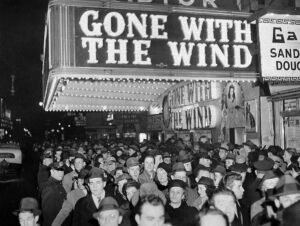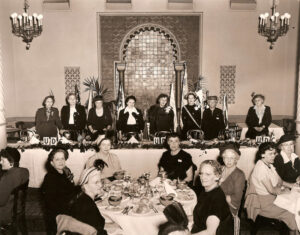calsfoundation@cals.org
Are There Any Confederate Monuments in Cinema?
Even long after its conclusion, the Civil War has remained a central theme in discussions surrounding the politics of remembrance, with its familiar tropes persisting to this day. While each period has seen its own debate over the legacy of the Civil War, the issue took on unprecedented prominence in 2019 amidst the wave of Black Lives Matter protests. Just as the protests brought attention to the issues of police brutality, systemic racism, and white supremacy, they worked to dismantle symbols of the Confederacy from their public pedestals. In a historic turn of events, Confederate monuments across the United States were being taken down, and along with them, other public displays of the Confederate past fell under intense public scrutiny.

As the events unfolded, another field that caught the eye of the public was the Civil War film. One notable debate centered around one of the most popular and profitable films of all time, Gone with the Wind (1939). After Oscar-winning screenwriter John Ridley’s published op-ed piece in the Los Angeles Times in which he highlighted the film’s role in perpetuating myths about the antebellum South, downplaying the horrors of slavery, and glorifying the Lost Cause, HBO Max decided to withdraw the film from its curated section. The platform later reintroduced the film with a disclaimer; an explanatory talk by Jacqueline Stewart, a professor in the University of Chicago’s cinema and media studies department; and an accompanying panel discussion, “The Complicated Legacy of Gone With the Wind,” from the TCM Classic Film Festival in April 2019, in an effort to provide proper historical context.
Among the structures that buttressed the Lost Cause ideology, one organization in particular faced growing attention in the wake of the protests: the United Daughters of the Confederacy (UDC). As the protestors took action against the conservative thread of the Civil War memory embodied in these monuments, the public was reminded of the vast contributions made by the UDC in the field, as it quickly became known that the organization built the vast majority of Confederate monuments and markers. Established in the aftermath of the Civil War, the UDC swiftly evolved into a prominent women’s ancestry organization and vocal advocate for what they deemed the truthful memory of the Confederate past. In addition to monument building, the group spearheaded memorial activities ranging from ephemeral spectacles to civil commemorations, educational initiatives, and benevolent endeavors.

A closer examination of the field of Civil War film reveals that the UDC’s impact didn’t end there. With the emergence of the Lost Cause narratives in cinema, the UDC co-opted films like The Birth of a Nation, So Red the Rose, Drums of the Deep South, and, notably, Gone with the Wind to serve its own agenda. After Gone with the Wind was produced, the UDC members spurred the film’s introduction to the American public by organizing a series of premieres held in the former states of the Confederacy. In Atlanta, Georgia, at the world premiere of the film, the UDC orchestrated numerous ceremonies tied to the myth of the Lost Cause, so-called Northern aggression, and the supposedly peaceful life in the South that existed prior to the sequence of war events that disrupted this romanticized way of life. With elegant balls, visits to historic sites, speeches, and ceremonies involving city officials, actors, and local history authorities, MGM executives painted the town and attracted crowds of tourists. As the group’s production of monuments waned during this period, it seems that the premiere of the highly anticipated film gave the UDC the means to focus the nation’s attention again on its version of the Civil War.
On the other side, the NAACP strongly denounced harmful racial stereotypes in the film, as highlighted by HBO Max’s materials. In other instances, the Society for Correct Civil War Information repudiated the film, while the members of the Grand Army of the Republic (GAR) and Daughters of Union Veterans—GAR auxiliary—leveled accusations about the film’s portrayal of Union soldiers. In this sense, the arguments raised by John Ridley aren’t new, and the gap between 1939 and today isn’t completely blank.
Nonetheless, the film has maintained popularity to this day, and Southern conservative groups like the UDC managed to align their cause with the film in the decades following its release. A notable example occurred in the 1960s when the UDC revived the film by hosting Gone with the Wind–themed costume balls, games, and screenings. While HBO executives rightly indicated that the film was highly revisionist from its inception, it seems that the question of supplementing the contemporary viewing experience of the film with proper context doesn’t end with offering a historical backdrop for the film’s representations. Rather, it extends to exploring how the film managed to attain its level of influence and success in the first place, and what sustained its unrivaled success from 1939 to the present day. How did it come about that among the sea of Civil War–themed productions, this particular film shaped collective memory the most? It isn’t only that the film mirrored harmful Lost Cause tropes, but also that it was embraced as an authentic portrayal of the conflict by interest groups involved in shaping the Civil War memory. Offering insights into the complexities of the film’s public reception unveils certain aspects of why it remained relevant over time, whose perspective it reflected, and how it fits into current discussions about the memory of the Civil War.
Guest post by Kristina Sedlarević, a PhD candidate in film studies at Goethe University in Frankfurt, Germany. She obtained her BA in art history at the University of Belgrade in Serbia in 2020 and her MA in aesthetics at Goethe University in 2023. Her research interests revolve around the American Civil War memory in Hollywood films and the political iconology of historical monuments. Her Legacies & Lunch appearance from November 2023, “The Role of Civil War Films in the Agenda of the United Daughters of the Confederacy,” is available here.




